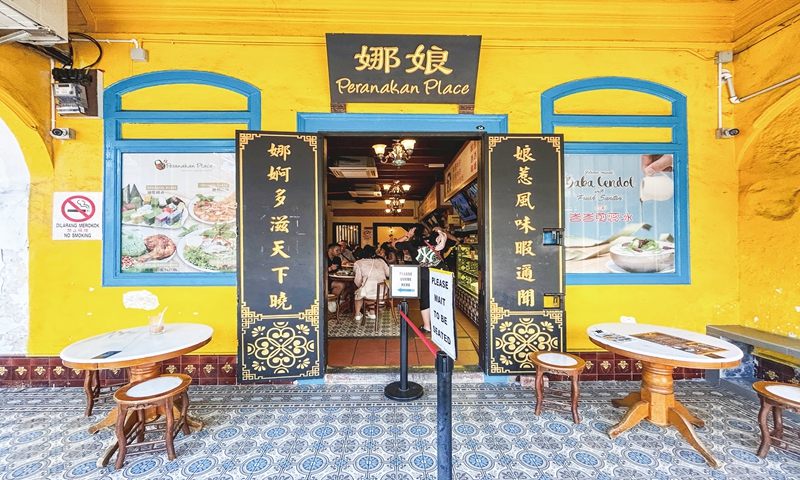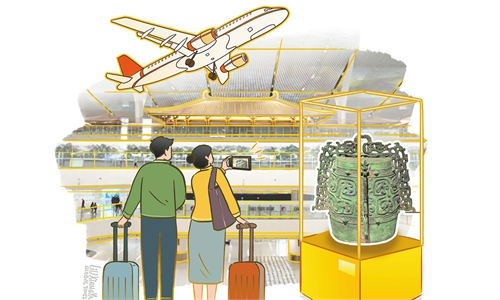ARTS / CULTURE & LEISURE
Delight in symphony of flavors, stories woven into every bite of Nyonya
Cultural fusion dances on the tongue

A Nyonya restaurant in Malaysia Photo: VCG
"Nyonya cuisine inherits Chinese cooking techniques such as stir-frying, steaming, and braising, while incorporating spices like lemongrass, coconut milk, and chili that are popular in Malaysia. This fusion results in a uniquely rich and layered flavor, which speaks to my heart," Wei Yi, who is living in Malaysia and has integrated into a local family with original Nyonya's culture, shared with the Global Times on Thursday.
Wei Yi's mother-in-law represents the fifth generation of Nyonya culture. In order to pass down the original recipes of the community's dishes, Wei began to learn from her mother-in-law about all kinds of dishes. During the process, Wei has developed deeper feelings about the history and culture of Nyonya, a community that attaches great importance to its traditions and is very meticulous about life.
The term "Nyonya" refers to the women of the Peranakan community, who are known for their distinct attire, customs, and culinary prowess. The origins of this culture can be traced back to the 15th and 16th centuries when Chinese merchants arrived in the Malay Archipelago for trade. Many of these merchants married local Malay women, leading to a unique blend of cultures that is still celebrated today.
As traveling to Southeast Asian countries like Malaysia becomes more convenient, more Chinese tourists are having the opportunity to taste and fall in love with the flavors of Nyonya cuisine. Sun Jiashan, an associate researcher at the Central Academy of Culture and Tourism Administration, had noticed that more than half of the people waiting in line outside a local restaurant were Chinese tourists. The power of delicious food cannot be overlooked; a plate of Udang masak lemak nenas, or a piece of Nyonya kueh can be a compelling reason to embark on a journey.
Inclusivity produces deliciousness
In a video posted by Wei on Chinese social media platform RedNote, she shows her daily life in Malaysia and details the raw materials, seasonings and the cooking process used to make her favorite Nyonya dish, Udang masak lemak nenas.
According to Wei, making the dish is an art form that requires patience and care. "The whole process needs about three to four hours. The time can create the rich flavor of Nyonya cuisine," said Wei.
To make the dish, a fragrant spice paste is created by frying minced garlic, ginger, and chili paste with sliced onions. Coconut milk is added to the pan, followed by pineapple chunks and torn kaffir lime leaves, which enhance the aroma and flavor. Prawns are then incorporated into the mixture, cooking until they turn pink and tender. The dish is seasoned with salt and a touch of sugar to balance the sweetness.
The ingredients of the dish use local materials, while the cooking techniques are from China. The culinary fusion symbolizes the profound exchange between China and Malaysia. Another dish Bak chang also combines elements from both Malaysian and Chinese culinary traditions.
Bak chang is a kind of Nyonya-style zongzi made similarly to a typical Chinese zongzi; however, the filling of a Bak chang is typically minced pork with candied winter melon, ground roasted peanuts, and a spice mix. The blue butterfly pea flower is used to color the rice with a shade of blue. The most striking feature of this kind of zongzi is indeed its vibrant appearance - bright blue glutinous rice paired with glistening white glutinous rice, making for a visually appealing dish. Taking a bite while it is still warm, the sticky softness of the rice gives way to a rich filling that offers a layered experience of flavors - savory, sweet, and spicy -providing diners with a delightful fusion of cultural tastes.
To make the Nyonya-style zongzi, local cooks collect ingredients from different places around the world, including wrapping leaves from East China's Anhui Province and rice from Thailand.

Nyonya cuisine in Malaysia Photo: VCG
Tasting tradition
As of today, Wei's mother-in-law prepares at least one dish of Nyonya cuisine every day. Through the making process, the fifth generation of Nyonya community likes to recall some past events of her family.
Wei 's mother-in-law told the Global Times that one of their traditions is to approach life with a sense of ceremony. For example, drinking tea involves special cups and accompanying snacks.
"In Nyonya culture, they always insist on maintaining their traditions. The precondition of the aunt of her mother-in-law agreeing to teach her the making methods of Nyonya cuisine was that she would never change the original recipes," said Wei.
As Ronald Gan, president of Persatuan Peranakan Baba Nyonya Malaysia, noted, the Nyonya culture retains Chinese traditions while incorporating the distinctive cultural traits of the local Malay people. They represent a fusion of Chinese and Malay cultures and are a unique cultural symbol and precious heritage of Malaysia.
"Nyonya culture not only upholds traditional Chinese cultural practices but also adapts to Malaysian society, representing the outcome of cultural exchange and interaction. This adaptability is also the reason for its enduring vitality," he told the Xinhua News Agency.




